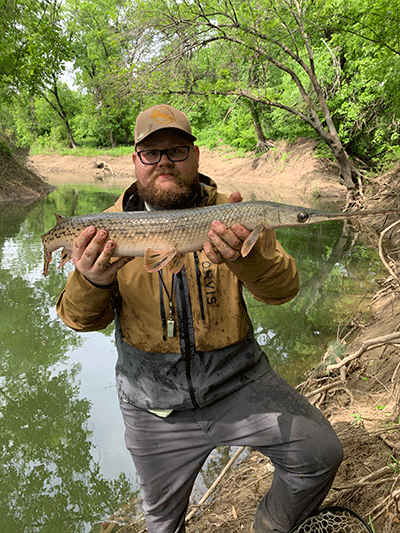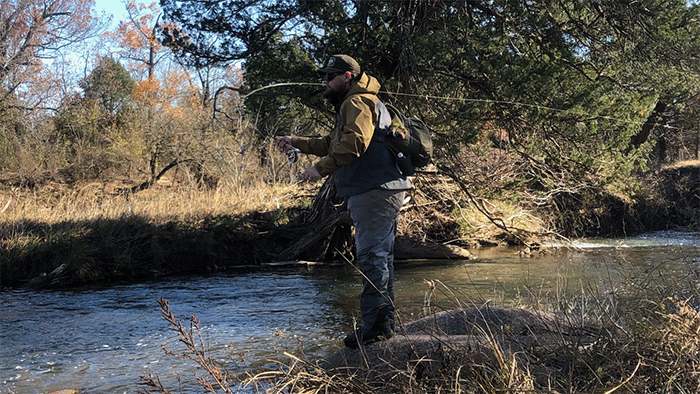
It’s my pleasure to share today the first part of an interview with Keagan Walls, a new friend we’ve made down here in Texas. Keagan is the acting fishing manager at the Orvis in Plano and one of the more avid regional fishers I’ve met since being down here, chasing a host of local and regional species (see his IG feed for some nifty gar on the fly pics), and spending time on freestones in mountain country as well as tagging some impressive redfish on the Texas and Louisiana above.
He’s also a master at the vice, a gifted fly fishing and tying teacher, and leader of guided trips via Orvis as well.
Please tell us a bit about your fly-fishing history – what were your first exposures to fly fishing and what led you to work in the industry full time?
Though I grew up fishing, I really didn’t get serious about fly fishing until I was 23 years-old. My first rod was a 6 piece, 7ft 4wt Shakespeare spin fly combo. Looking back now, it was probably the worst thing to learn on. A broomstick would have been better option.
When I was a fledgling fly fisher, I went into an Orvis store and talked to one of the guys in the fishing department and told him I was having trouble catching trout on the Lower Mountain Fork River. I was blown away he took the time and showed me how to set up a double nymph rig when he could’ve just sold me some flies or new fishing gadget. I now work at that same store and I have had that same interaction with other people. It’s so awesome to be part of someone’s fishing journey and for them to come back and show me pictures of their catches.
You spend a fair bit of your professional fly shop time teaching people the fundamentals of tying and fishing with Orvis’ impactful introductory programs at Orvis Plano; what’s the best advice you’d give ahead of time to an absolute novice signed up for your casting class?
 Bass fishing reigns supreme in Texas and that drives the so a lot people have a conventional fishing background. Most fishermen are already equipped with the fundamentals, such as knowing what areas to fish and having a feel for what color of lure works best. All that knowledge carries over to the fly side of things, except you’re casting fur and feather instead plastic. The cast is probably the most daunting to a new fly angler, but you’d be surprised how may fish you can catch with a 20 ft. cast, so you don’t always that perfect 80ft cast to be successful on the water.
Bass fishing reigns supreme in Texas and that drives the so a lot people have a conventional fishing background. Most fishermen are already equipped with the fundamentals, such as knowing what areas to fish and having a feel for what color of lure works best. All that knowledge carries over to the fly side of things, except you’re casting fur and feather instead plastic. The cast is probably the most daunting to a new fly angler, but you’d be surprised how may fish you can catch with a 20 ft. cast, so you don’t always that perfect 80ft cast to be successful on the water.
What is the essential point (or points) you’d want to make sure every first timer with a fly rod in their hand remembers?
Practice, practice, practice. However, don’t beat yourself up about it. If you get frustrated, take and step back and take a breather. If it was easy everyone would do it. Above all its supposed to be fun!
As an accomplished tyer at the vise, how did you get started tying your own flies, and what are some of your favorite ties?
I used to draw and paint when I was younger and fly tying has now turned into my creative outlet. I’m a sucker for big streamers since that’s what I mostly use for bass, but I still enjoy tying nymphs and dries as well.
How about two or three of your best pieces of advice to give someone who wants to tie at home but isn’t sure where to get started.
Pick one or two patterns that you’ll fish and work on tying them consistently.
When I learn a new pattern, I’ll tie it in the largest size I’ll ever fish it. For example, If I’m learning a new mayfly nymph, I’ll tie a size 12. That way it’s easier to learn your proportions on a larger platform then once you’re comfortable with the tie you’re able to scale them down without too much trouble.


